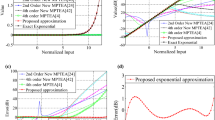Abstract
A new modified pseudo-Taylor exponential approximation is presented for realizing a current-to-current exponential function generator. The proposed approximation for exponential function generation has been implemented using translinear principle of MOSFETs operating in weak inversion region. The SPECTRE simulation tool from Cadence, with 180 nM CMOS process parameters, has been utilized for testing the workability of the CMOS implementation of the proposed approximation, which uses only \(\pm 0.5\hbox {V}\) power supply. The post-layout simulation results of the proposed CMOS exponential generator, thus, consume only \({\approx }119\,\hbox {nW}\) power and produce 51.6 dB range of linear-in-dB output with only \(\pm 0.21\,\hbox {dB}\) error while occupying an area of \(0.26\,\upmu \hbox {m}^{2}\).





Similar content being viewed by others
Notes
While the extension of 3 dB frequency of the proposed exponential generator can be left to future research for utilizing them in high-frequency applications of AGC/VGA such as WLAN receivers, CDMA/WCDMA receivers, GPS receivers and disk drive electronics, nevertheless, the biomedical signals (for instance, ECG or EEG), which are of low-frequency range, e.g., see [9, 11, 20], it can more effectively be processed through amplifiers of the analog front ends in biomedical electronic systems, utilizing the proposed exponential generator. Also, our proposition, with other notable superior features, suites more to many implantable miniature biodevices, namely hearing aids and pacemakers.
References
K.M. Al-Tamimi, M.A. Al-Absi, A \(6.13\mu \text{ W }\) and 96 dB CMOS exponential generator. IEEE Trans. VLSI Syst. 22(11), 2440–2445 (2014)
T. Arthansiri, V. Kasemsuwan, Current-mode pseudo-exponential-control variable-gain amplifier using fourth-order Taylor’s series approximation. Electron. Lett. 42(7), 379–380 (2006)
D.M. Binkley, Tradeoffs and Optimization in Analog CMOS Design (Wiley, New York, 2007)
F. Carrara, O. Filoramo, G. Palmisano, High-dynamic range variable-gain amplifier with temperature compensation and linear-in-decibel gain control. Electron. Lett. 40(6), 363–364 (2004)
C.-C. Chang, S.-I. Liu, Current-mode pseudo-exponential circuit with tunable input range. Electron. Lett. 36(16), 1335–1336 (2000)
C.-C. Chang, S.-I. Liu, Pseudo-exponential function for MOSFETs in saturation. IEEE Trans. Circuits Syst.-II Analog Digit. Signal Process 47(11), 1318–1321 (2000)
I. Choi, H. Seo, B. Kim, Accurate dB-linear variable gain amplifier with gain error compensation. IEEE J. Solid-State Circuits 48(2), 456–464 (2013)
Q.-H., Duong, T.-K. Nguyen, S.-G. Lee, in dB-Linear V-I converter with tunable input and output range. Proceedings of IEEE 46th Midwest Symposium 1, pp. 201–204 (2012)
A. Eftekhar, S. Paraskevopoulou, T. Constandinou, in Towards a next generation neural interface: optimizing power, bandwidth and data quality, Proceedings of IEEE Biomedical Circuits and Systems Conference (BioCAS), pp. 122–125 (2010)
M. Gupta, R. Pandey, Low-voltage FGMOS based analog building blocks. Microelectron J 42(6), 903–912 (2011)
R.R. Harrison, C. Charles, A low-noise CMOS amplifier for neural recording applications. IEEE J. Sol. State Circuits 38(6), 958–965 (2003)
V. Kalenteridis, S. Vlassis, S. Siskos, A CMOS linear-in-dB VGA based on exponential current generator. 6th International Conference on Design and Technology of Integrated Systems in Nanoscale Era (DTIS), pp. 1-4 (2011)
V. Kalenteridis, S. Vlassis, S. Siskos, 1.5-V CMOS exponential current generator. Analog Integr. Circuits Signal Process 72(2), 333–341 (2012)
C.-H. Kao, W.-P. Lin, C.-S. Hsieh, Low-voltage low-power current mode exponential circuit. IEE Proc. Circuits Dev. Syst. 3, 633–635 (2005)
N.V. Karanjakar, R.R. Sahoo, M.S. Baghini, Improved accuracy pseudo-exponential function generator with applications in analog signal processing. IEEE Trans. VLSI Syst. 18(9), 1381–1383 (2010)
Y. Karimi, A. Abrishamifar, in A low power configurable analogue block. Proc. 19th ICEE, pp. 1–5 (2011)
M. Kumngern, J. Chanwutitum, K. Dejhan, in Simple CMOS current-mode exponential function generator circuit. Proc. Of ECTI-CON, pp. 709–711 (2008)
B. Minch, Synthesis of static and dynamic multiple-input translinear element networks. IEEE Trans. Circuits Syst-I, Reg. Pap. 51(2), 409–421 (2004)
A. Motamed, C. Hwang, M. Ismail, A low-voltage low-power wide-range CMOS variable gain amplifier. IEEE Trans. Circuits Syst.-II Analog Digital Signal Process 45(7), 800–811 (1998)
S.E. Paraskevopoulou, T.G. Constandinou, in An ultra-low-powerfront-end neural interface with automatic gain for uncalibrated monitoring, 2012 IEEE International Symposium on Circuits and Systems (South Korea, Seoul, 2012), pp. 193–196
S.S. Rajput, S. Jamuar, Low voltage analog circuit design techniques. IEEE Circuits Syst. Mag. 2(1), 24–42 (2002)
E. Seevinck, R. Wiegerink, Generalized translinear circuit principle. IEEE J. Sol.-State Circuits. 26(8), 1098–1102 (1991)
R. Senani, D.R. Bhaskar, V.K. Singh, R.K. Sharma, Chapter-9 of Sinusoidal Oscillators and Waveform Generators using Modern Electronic Circuit Building Blocks (Springer, Berlin, ISBN 978-3-319-23711-4, 2016)
S. Vlassis, CMOS current-mode pseudo-exponential function circuit. Electron. Lett. 37(8), 471–472 (2001)
Author information
Authors and Affiliations
Corresponding author
Additional information
An erratum to this article is available at http://dx.doi.org/10.1007/s00034-017-0509-6.
Rights and permissions
About this article
Cite this article
Srivastava, P., Sharma, R.K. A Novel Exponential Approximation with \(\pm 0.21\,\hbox {dB}\) Error for Realizing an Improved CMOS Exponential Function Generator. Circuits Syst Signal Process 36, 2941–2957 (2017). https://doi.org/10.1007/s00034-016-0451-z
Received:
Revised:
Accepted:
Published:
Issue Date:
DOI: https://doi.org/10.1007/s00034-016-0451-z




